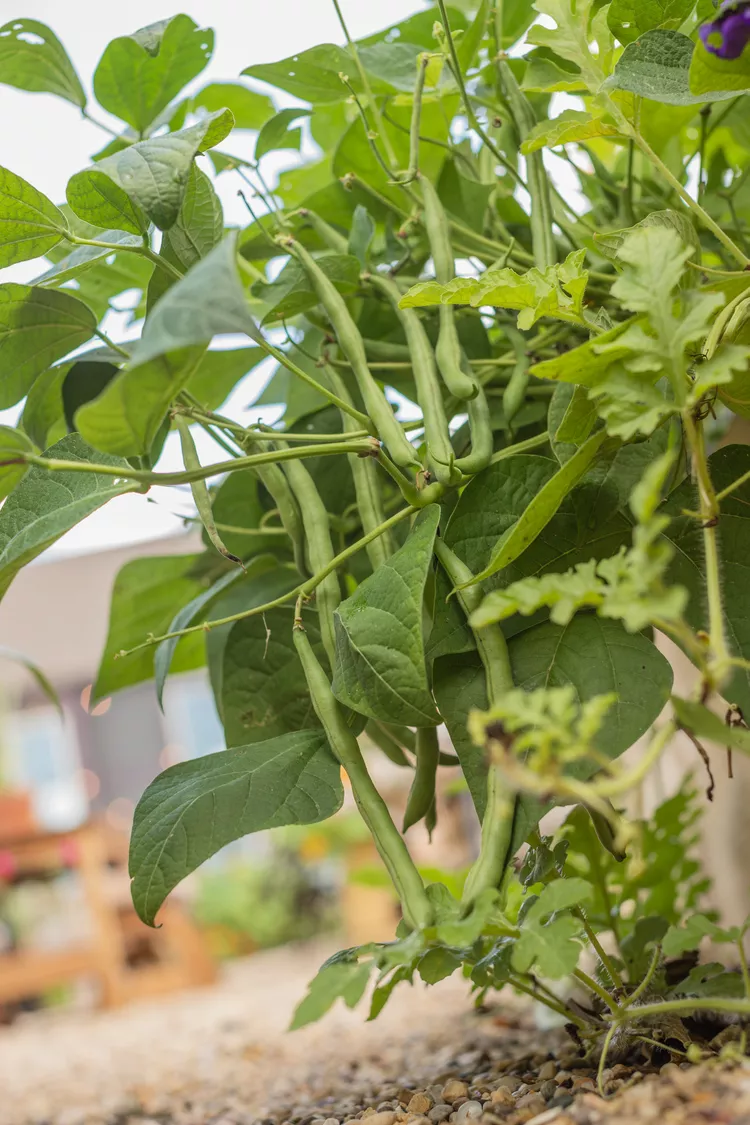Summer vegetable gardens can be both bountiful and easy to grow. That way, you can spend less time sweating out in the sun and more time sipping lemonade under the shade of a large tree. Whether purchased as seedlings to transplant into your garden or direct seeded, these 9 summer veggies are fast-growing, easy to care for, and will yield a prodigious amount of fresh produce, even for new gardeners.
Green Beans
Homegrown green beans are one of summer’s savory treats. You can eat the pods straight off the plant for that fresh, vibrant crunch of flavor, or take them in the house and try this recipe for blistered green beans.
Pole beans will climb up a trellis or other support and typically provide a higher yield from their longer vines. Bush beans are compact and easygoing. Sow beans directly into the garden–they’ll sprout in a few days and grow rapidly.
Bell Peppers
Sweet bell peppers are not hard to grow but the red, yellow, and orange ones can get pricey in the store. You’ll just need a little patience for them to change color and get sweet. A few large sweet pepper plants will give you plenty of peppers once the harvest starts. A great way to use them up is with these stuffed pepper recipes.
Cucumbers
Like beans, cucumbers are available in vine or bush form, and the vining types are easily trained to go vertical. Fast growers, these plants will pump out crunchy cucumbers if given sun, about an inch of water per week, and fertile soil. Cucumbers are delicious fresh or pickled, so you'll have no trouble putting your bounty to good use.
Eggplant
A relative of the tomato, eggplant is a beauty to grow in a summer garden. They love heat, and their dark-colored fruits lend themselves to lots of tasty recipes. Water eggplants consistently, from below, if possible, and mulch under the plants. When harvesting, use a knife to cut the stem–don’t try to yank them off or you may damage the plant.
To grow larger eggplants, pinch off all but half a dozen flowers per plant.
Melons
Okay, melons are considered fruits, and this is list of vegetables, but a summer garden doesn’t seem complete without a few cantaloupes or watermelons. Home-grown varieties are typically much sweeter than their store-bought counterparts because you can pick and eat them at peak ripeness. These plants are easy to direct sow–just poke a few seeds down in the soil, cover, and water. The vines can be trained to climb up a trellis or cattle panel to save space and look fantastic.
Okra
Gumbo, anyone? Another heat lover, okra is an excellent summer vegetable commonly grown in the South, but northern growers can successfully grow it too. Okra plants can get large, so leave about 18 inches between plants and 2-3 feet between rows. Pruning the top of the plants when they reach about chest high will encourage bushier growth, resulting in a bigger harvest.
Harvest the pods when they are about 3-4 inches long. If they get much larger or too old, their quality lessens. Okra flowers are large and beautiful, so this plant does double duty as a flowering beauty and a tasty treat. Red varieties are also available.
Summer Squash
Summer squashes, such as patty pan, yellow crookneck, and especially zucchini, have a reputation for being almost too prolific. Especially around August, people might start locking their cars and not answering the door when they see you coming with yet more zucchini to share. These plants are typically direct-seeded and will produce heavily if kept weed-free in fertile soil and with adequate moisture. Water from below with a soaker hose or drip tape and mulch around the plants to reduce powdery mildew.
Sweet Corn
Freshly harvested corn from your garden is a sweet summer treat. The old saying is to get the water boiling before you pick the corn because the sugars in the kernels start converting to starch as soon as it’s picked.
Direct seed corn in the garden, and plant in a block rather than long rows–corn is wind pollinated and won’t achieve good pollination in one long row, leading to ears that don’t completely fill with kernels. Corn has shallow roots, so make sure to water it during dry periods.
Tomatoes
No list of summer vegetables would be complete without tomatoes. Yes, technically, they are a fruit, but they're more often thought of as vegetables. There are seemingly endless varieties of tomatoes to choose from, and most are easy to grow. Certain types of tomatoes are more suited to specific uses like slicing, canning for sauces, or juicing. However, don’t think you can’t add slices of Roma tomatoes to your burger just because it’s a paste tomato.
To make your summer gardening even easier, apply mulch under these vegetables. Mulch will suppress weeds and keep the soil covered and cool, reducing watering needs.
Also consider installing a soaker hose or drip tape irrigation system to make watering more manageable. They’re inexpensive and easy to set up and, combined with mulch, will go a long way toward reducing problems like powdery mildew and blight of tomatoes.
Summer Veggies for Fall Harvest
Don’t forget summer vines grow fall squashes. Traditional fall-harvested crops like pumpkins, winter squashes, parsnips, rutabagas, and turnips all need a place in your garden throughout the summer. Some other crops like kale, cabbage, beets, fall carrots, and greens are started in late summer and grow best in the cool days of early autumn.




















